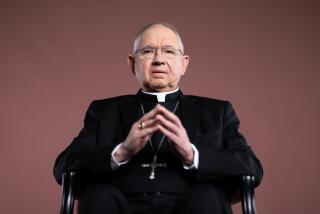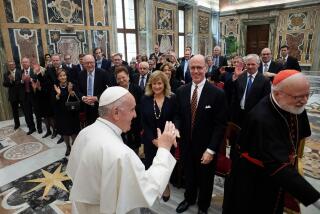CHURCH CHAT II
- Share via
As a former teacher in Los Angeles archdiocesan schools, I’m writing to object to the style of Father Gregory Coiro’s letter (Dec. 11).
In an attempt to develop a vitriolic tone in his attack on Christopher Knight’s Dec. 4 review of illuminated manuscripts, Father Coiro, who identifies himself as the director of the Archdiocesan Office of Public Affairs, falls into a habit often encountered in the writings of high school students: the habit of propping up nouns with tautological adjectives.
Phrases like “insulting, anti-Christian” and “snide affront to our Lord” and “intellectually lazy bigot” weaken rather than intensify the tone he tries to express, adding nothing to the meaning. It is probably a good thing that Calendar carried a letter from another contributor clarifying the “facts” about Mary’s Annunciation .
Instead of helping to demonstrate a new standard for writing in archdiocesan schools, an administrator in the Chancery Office once again has an assortment of English teachers tearing out their collective hair.
BERNARD KELLY
Long Beach
One more time: Regarding the responses to Knight’s misuse of terms in his Dec. 4 piece on illuminated manuscripts, please let me take a crack at this, from the Protestant side.
Concerning basic definitions:
* Immaculate conception . The Rev. Coiro is correct in his definition, yet both he and reader Ruth Whelan Trend neglected to mention that this is a Roman Catholic tradition that is rejected by Protestants because of its complete lack of biblical support (the same is true for the alleged names of Mary’s parents mentioned by Trend). Also, from the Protestant side, against Trend, the stain of sin is removed by Christ’s death on the cross and its appropriation by faith by those who believe--not by baptism.
* The Annunciation . The Rev. Coiro is, again, correct in his location of the announcement to Mary in Luke 1. However, a careful reading of the text will show that the angel was not asking for Mary’s consent; rather, he was telling her what God had decided to do through her--a big difference.
* The Incarnation . The Rev. John O’Byrne correctly defines the Incarnation as God taking on human flesh in the person of Jesus Christ. However, the way his letter is worded, he appears to be confusing the Incarnation and the Annunciation, considering them to be two sides of the same coin. Rather, they are two separate events--the former involving Jesus, the latter involving Mary before Jesus’ miraculous conception.
Whew! Hope that’s straightened out. ‘Nuff said?
RICHARD T. ZUELCH
Fellowship of Grace
Brethren Churches
Long Beach
The Rev. Coiro of the L.A. Archdiocese chastises Times art critic Knight’s review as doing a disservice to the Immaculate Conception, ending: “If there’s anything worse than a bigot, it’s an intellectually lazy bigot.”
My answer to the Rev. Coiro: “If there’s anything worse than religious dogma, it’s intellectually lazy Catholic dogma.”
BURT WILSON
Simi Valley
I object to the Rev. Coiro’s objection to Knight’s review.
To be so easily offended by someone whose beliefs differ from yours in a free society is immature indignation, presumptuous and self-righteous. And Lord knows there’s a sin in there somewhere. Of course, the whole tone of the Rev. Coiro’s letter was of religious grandstanding, and why should Times readers have to suffer that?
There’s no basis on which to accuse Knight of sin just because he doesn’t believe in Mary worship. There is no biblical foundation for this belief. Simply, Mary worship is idol worship and prayer to the dead.
If there’s anything worse than a religious grandstander, it’s the one who’d lead you to believe something and not give you all the facts.
C. C. BALLOU
Corona


